New Methodology for Parasitic Resistance Extraction and Capacitance Correction in RF AlGaN/GaN High Electron Mobility Transistors
Abstract
:1. Introduction
2. Materials and Measurement of the Equivalent Circuit
2.1. Fabrication
2.2. Problem Statement
2.3. New Method of Resistance Extraction
3. Results and Discussion
3.1. Resistance Extraction from Cold-FET
3.2. Parasitic Capacitance Extraction by Dambrine’s Model
3.3. Model and Measurement Data Validation
4. Conclusions
Author Contributions
Funding
Data Availability Statement
Conflicts of Interest
References
- Mishra, U.K.; Shen, L.; Kazior, T.E.; Wu, Y.F. GaN-based RF power devices and amplifiers. Proc. IEEE 2008, 96, 287–305. [Google Scholar] [CrossRef]
- Chakraborty, S.; Kim, T.W. Investigation of mean-time-to-failure measurements from AlGaN/GaN high-electron-mobility transistors using Eyring model. Electronics 2021, 10, 3052. [Google Scholar] [CrossRef]
- Chakraborty, S.; Kim, T.W. Comprehensive Schottky Barrier Height Behavior and Reliability Instability with Ni/Au and Pt/Ti/Pt/Au on AlGaN/GaN High-Electron-Mobility Transistors. Micromachines 2022, 13, 84. [Google Scholar] [CrossRef] [PubMed]
- Amir, W.; Shin, J.W.; Shin, K.Y.; Kim, J.M.; Cho, C.Y.; Park, K.H.; Hoshi, T.; Tsutsumi, T.; Sugiyama, H.; Matsuzaki, H.; et al. A quantitative approach for trap analysis between Al0.25Ga0.75N and GaN in high electron mobility transistors. Sci. Rep. 2021, 11, 22401. [Google Scholar] [CrossRef]
- Chakraborty, S.; Amir, W.; Shin, J.W.; Shin, K.Y.; Cho, C.Y.; Kim, J.M.; Hoshi, T.; Tsutsumi, T.; Sugiyama, H.; Matsuzaki, H.; et al. Explicit Thermal Resistance Model of Self-Heating Effects of AlGaN/GaN HEMTs with Linear and Non-Linear Thermal Conductivity. Materials 2022, 15, 8415. [Google Scholar] [CrossRef] [PubMed]
- Shin, K.-Y.; Shin, J.-W.; Chakraborty, S.; Amir, W.; Shin, C.-S.; Kim, T.-W. Trap Behavior of Metamorphic HEMTs with Pulsed IV and 1/f Noise Measurement. In Proceedings of the ESSDERC 2022—IEEE 52nd European Solid-State Device Research Conference (ESSDERC), Milan, Italy, 19–22 September 2022; pp. 324–327. [Google Scholar] [CrossRef]
- Caddemi, A.; Crupi, G.; Donato, N. A robust and fast procedure for the determination of the small signal equivalent circuit of HEMTs. Microelectron. J. 2004, 35, 431–436. [Google Scholar] [CrossRef]
- Dambrine, G.; Cappy, A.; Heliodore, F.; Playez, E. A new method for determining the FET small-signal equivalent circuit. IEEE Trans. Microw. Theory Tech. 1988, 36, 1151–1159. [Google Scholar] [CrossRef]
- Amir, W.; Shin, J.; Shin, K.; Chakraborty, S.; Cho, C.; Kim, J.; Lee, S.; Hoshi, T.; Tsutsumi, T.; Sugiyama, H.; et al. Performance Enhancement of AlGaN/GaN HEMT via Trap-State Improvement. IEEE Trans. Electron Devices 2023, 170, 2988–2993. [Google Scholar] [CrossRef]
- Amir, W.; Chakraborty, S.; Kwon, H.-M.; Kim, T.-W. Impact of Charge-Trapping Effects on Reliability Instability in AlxGa1−xN/GaN High-Electron-Mobility Transistors with Various Al Compositions. Materials 2023, 16, 4469. [Google Scholar] [CrossRef]
- Amir, W.; Shin, J.W.; Chakraborty, S.; Shin, K.Y.; Hoshi, T.; Tsutsumi, T.; Sugiyama, H.; Kwon, H.M.; Kim, T.W. Instability Assessment of AlGaN/GaN High Electron Mobility Transistors Under High Drain Current Condition. In Proceedings of the Asia-Pacific Microwave Conference (APMC 2022), Yokohama, Japan, 29 November–2 December 2022; pp. 184–186. [Google Scholar]
- Cuerdo, R.; Calle, F.; Braña, A.F.; Cordier, Y.; Azize, M.; Baron, N.; Chenot, S.; Muñoz, E. High temperature behaviour of GaN HEMT devices on Si(111) and sapphire substrates. Phys. Status Solidi C 2008, 5, 1971–1973. [Google Scholar] [CrossRef]
- Tan, W.; Uren, M.; Fry, P.; Houston, P.; Balmer, R.; Martin, T. High temperature performance of AlGaN/GaN HEMTs on Si substrates. Solid-State Electron. 2006, 50, 511–513. [Google Scholar] [CrossRef]
- Crupi, G.; Xiao, D.; Schreurs, D.M.M.P.; Limiti, E.; Caddemi, A.; De Raedt, W.; Germain, M. Accurate multibias equivalent-circuit extraction for GaN HEMTs. IEEE Trans. Microw. Theory Tech. 2006, 54, 3616–3621. [Google Scholar] [CrossRef]
- Vandamme, E.P.; Schreurs, D.M.M.P.; Van Dinther, C. Improved three-step de-embedding method to accurately account for the influence of pad parasitics in silicon on-wafer RF test-structures. IEEE Trans. Electron Devices 2001, 48, 737–742. [Google Scholar] [CrossRef]
- Tiemeijer, L.F.; Havens, R.J.; Jansman, A.B.M.; Bouttement, Y. Comparison of the “Pad-Open-Short” and for Accurate On-Wafer RF Characterization of High-Quality Passives. IEEE Trans. Microw. Theory Tech. 2005, 53, 723–729. [Google Scholar] [CrossRef]
- Cho, H.; Burk, D. A three-step method for the de-embedding of high-frequency S-parameter measurements. IEEE Trans. Electron Devices 1991, 38, 1371–1375. [Google Scholar] [CrossRef]
- Koolen, M.C.A.M.; Geelen, J.A.M.; Versleijen, M.P.J.G. An improved de-embedding technique for on-wafer high-frequency characterization. In Proceedings of the 1991 Bipolar Circuits and Technology Meeting, Minneapolis, MN, USA, 9–10 September 1991; pp. 188–191. [Google Scholar] [CrossRef]
- Bazzi, J.; Kassem, H.; Curutchet, A.; Pourchon, F.; Derrier, N.; Celi, D.; Zimmer, T. A two-step de-embedding method valid up to 110 GHz. In Proceedings of the 2017 29th International Conference on Microelectronics (ICM), Beirut, Lebanon, 10–13 December 2017; pp. 1–4. [Google Scholar] [CrossRef]
- Kolding, T.E. A four-step method for de-embedding gigahertz on-wafer CMOS measurements. IEEE Trans. Electron Devices 2000, 47, 734–740. [Google Scholar] [CrossRef] [Green Version]
- Luo, J.; Zhang, L.; Wang, Y. A Distributed De-Embedding Solution for CMOS mm-Wave On-Wafer Measurements Based-on Double Open-Short Technique. IEEE Microw. Wirel. Compon. Lett. 2013, 23, 686–688. [Google Scholar] [CrossRef]
- Zhang, B.; Xiong, Y.-Z.; Wang, L.; Hu, S.; Li, J.L.-W. On the De-Embedding Issue of Millimeter-Wave and Sub-Millimeter-Wave Measurement and Circuit Design. IEEE Trans. Compon. Packag. Manuf. Technol. 2012, 2, 1361–1369. [Google Scholar] [CrossRef]
- Yau, K.H.K.; Sarkas, I.; Tomkins, A.; Chevalier, P.; Voinigescu, S.P. On-wafer S-parameter de-embedding of silicon active and passive devices up to 170 GHz. In Proceedings of the 2010 IEEE MTT-S International Microwave Symposium, Anaheim, CA, USA, 23–28 May 2010; pp. 600–603. [Google Scholar] [CrossRef]
- White, P.M.; Healy, R.M. Improved equivalent circuit for determination of MESFET and HEMT parasitic capacitances from ‘coldfet’ measurements. IEEE Microw. Guid. Wave Lett. 1993, 3, 453–454. [Google Scholar] [CrossRef]
- Yang, C.K.; Roblin, P.; De Groote, F.; A Ringel, S.; Rajan, S.; Teyssier, J.P.; Poblenz, C.; Pei, Y.; Speck, J.; Mishra, U.K. Pulsed-IV Pulsed-RF Cold-FET Parasitic Extraction of Biased AlGaN/GaN HEMTs Using Large Signal Network Analyzer. IEEE Trans. Microw. Theory Tech. 2010, 58, 1077–1088. [Google Scholar] [CrossRef]
- Zhang, H.; Ma, P.; Lu, Y.; Zhao, B.; Zheng, J.; Ma, X.; Hao, Y. Extraction method for parasitic capacitances and inductances of HEMT models. Solid-State Electron. 2017, 129, 108–113. [Google Scholar] [CrossRef]
- Kim, J. A New GaN HEMT Small-Signal Model Considering Source via Effects for 5G Millimeter-Wave Power Amplifier Design. Appl. Sci. 2021, 11, 9120. [Google Scholar] [CrossRef]
- Lu, J.; Wang, Y.; Ma, L.; Yu, Z. A new small-signal modeling and extraction method in AlGaN/GaN HEMTs. Solid-State. Electron. 2008, 52, 115–120. [Google Scholar] [CrossRef]
- Fukui, H. Determination of the Basic Device Parameters of a GaAs MESFET. Bell Syst. Tech. J. 1979, 58, 771–797. [Google Scholar] [CrossRef]
- Lee, K.W.; Lee, K.; Shur, M.S.; Vu, T.T.; Roberts, P.C.T.; Helix, M.J. Source drain and gate series resistance and electron saturation velocity in ion implanted GaAs FETs. IEEE Trans. Electron Devices 1985, 32, 5–10. [Google Scholar] [CrossRef]
- Byun, Y.H.; Shur, M.S.; Peczalski, A.; Schuermeyer, F.L. Gate-Voltage Dependence of Source and Drain Series Resistances and Effective Gate Length in GaAs MESFET’s. IEEE Trans. Electron Devices 1988, 35, 1241–1246. [Google Scholar] [CrossRef]
- Jarndal, A.; Kompa, G. A new small-signal modeling approach applied to GaN devices. IEEE Trans. Microw. Theory Tech. 2005, 53, 3440–3448. [Google Scholar] [CrossRef]

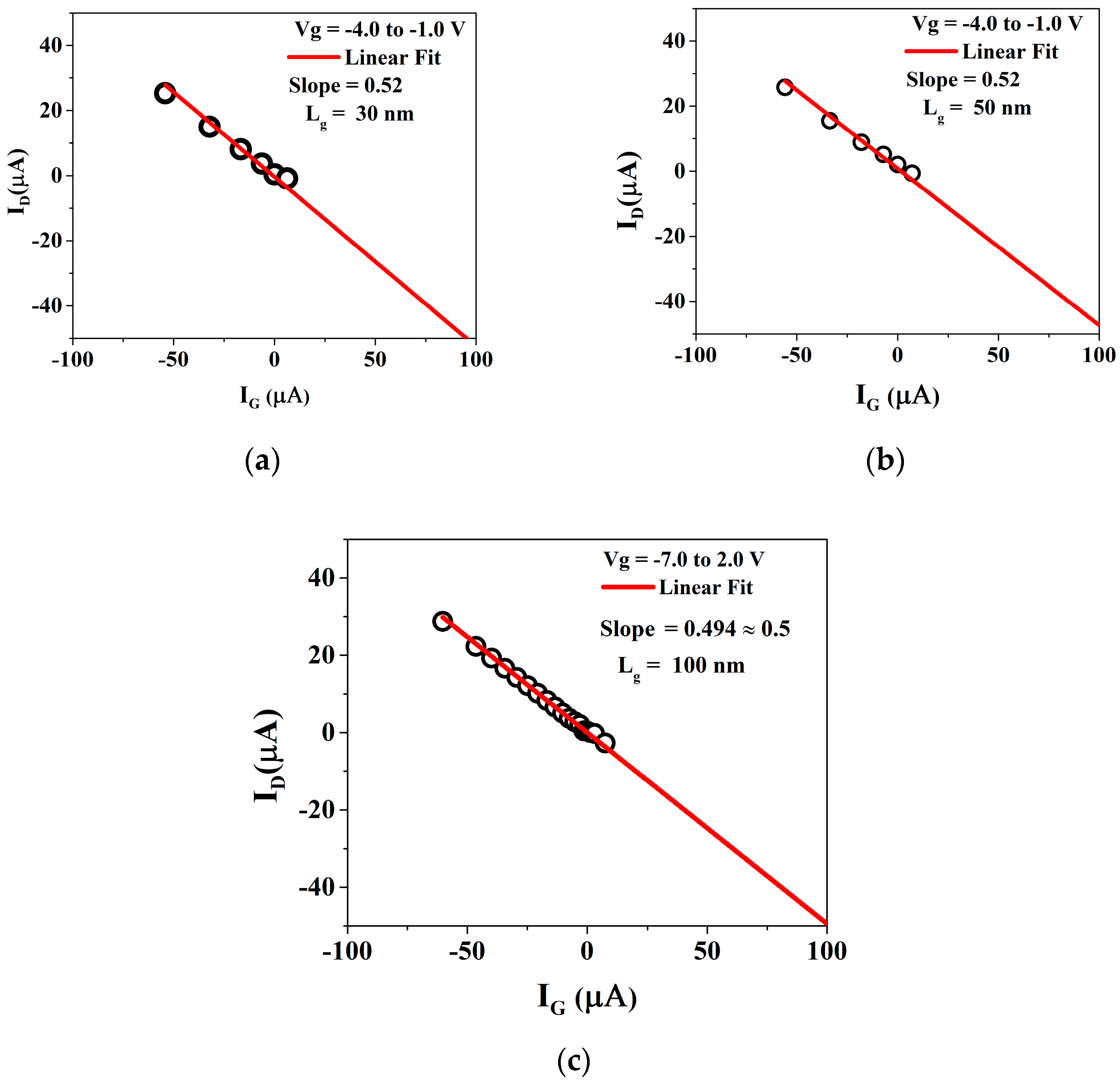
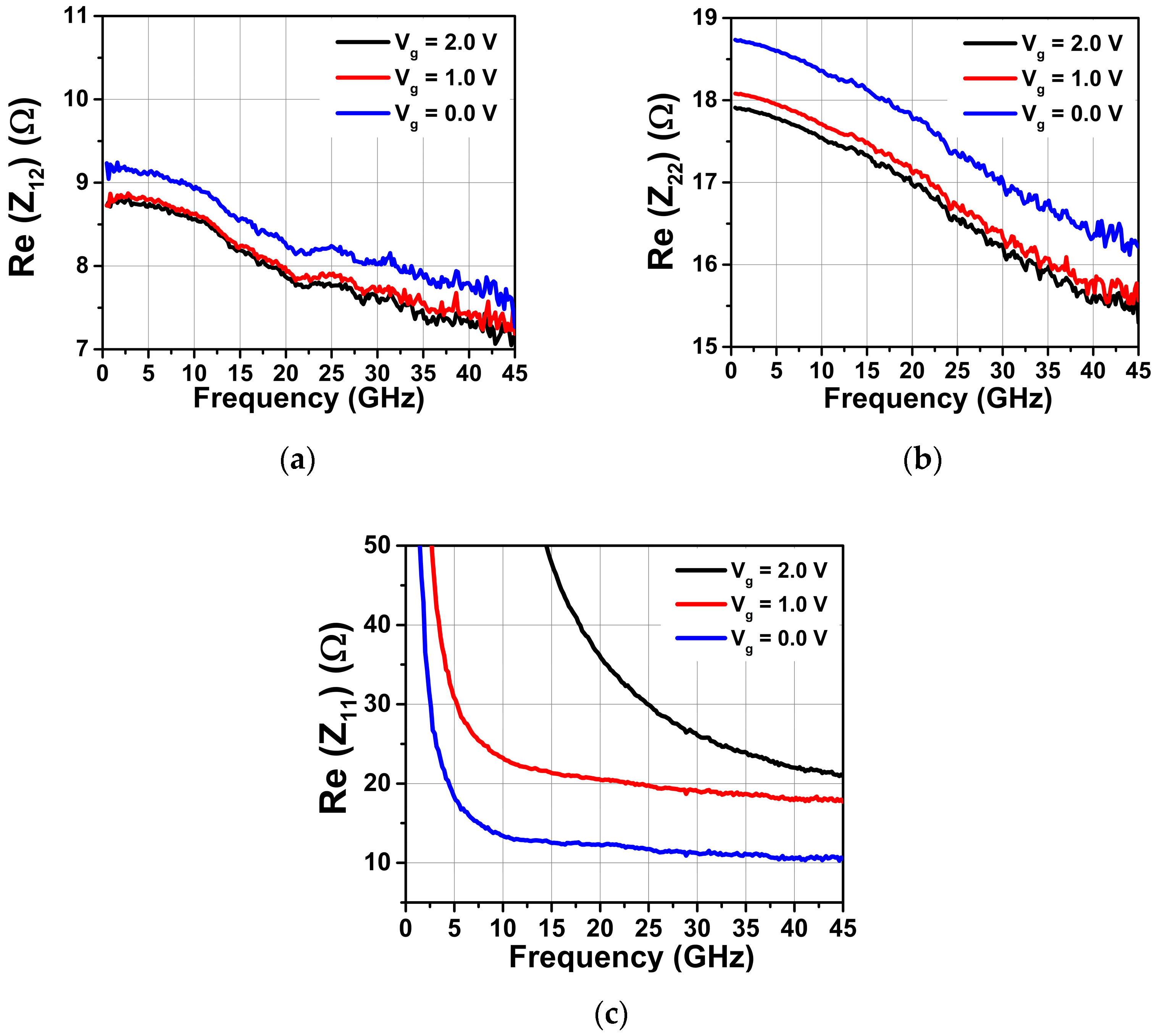
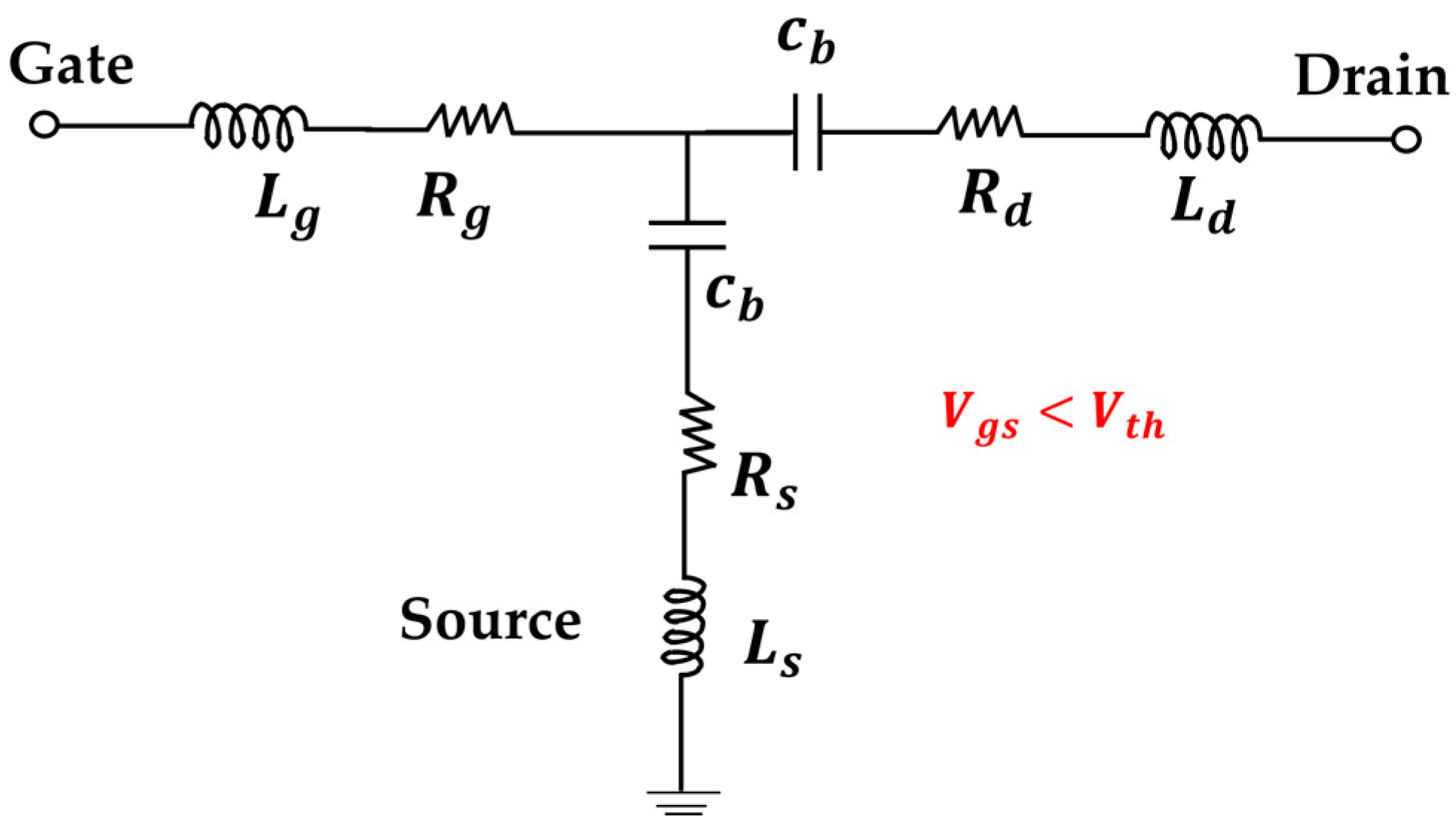

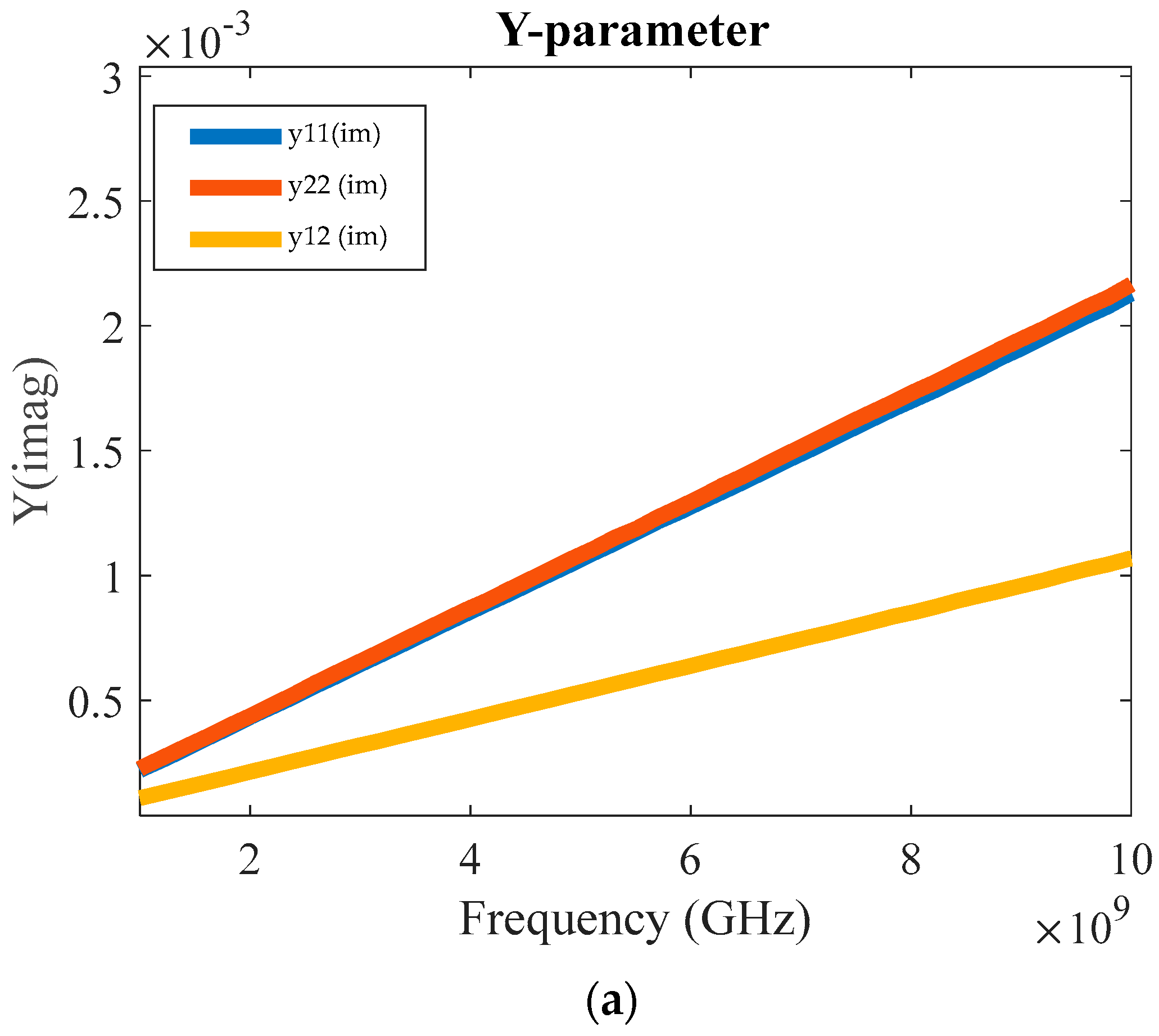
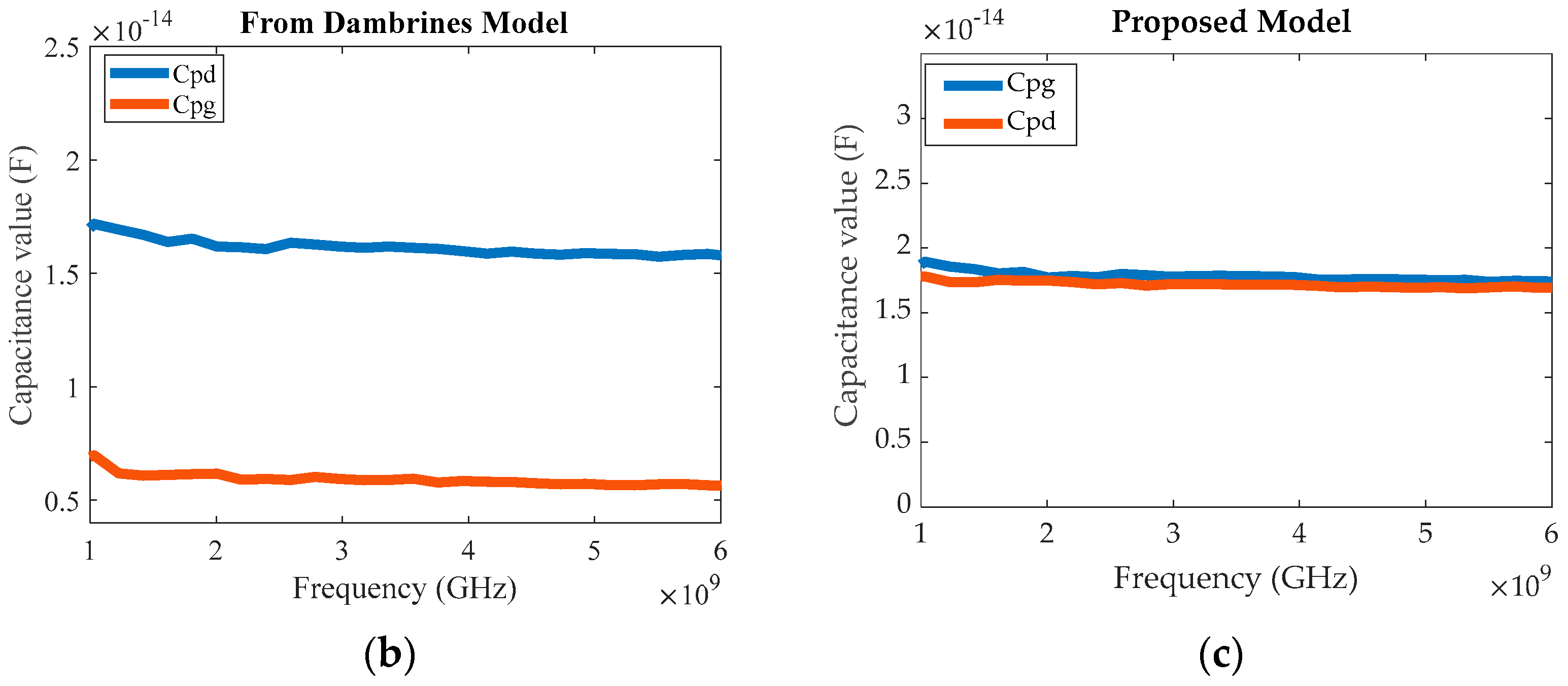
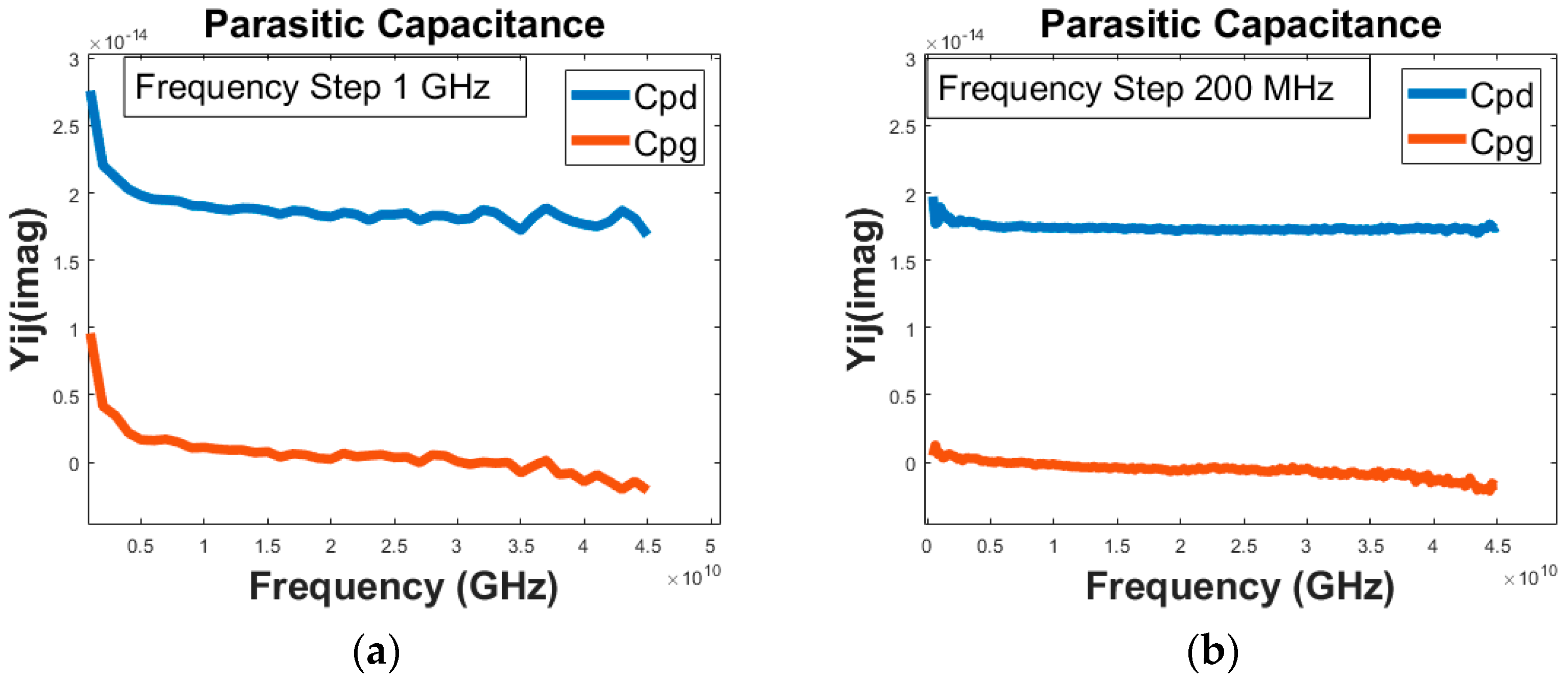
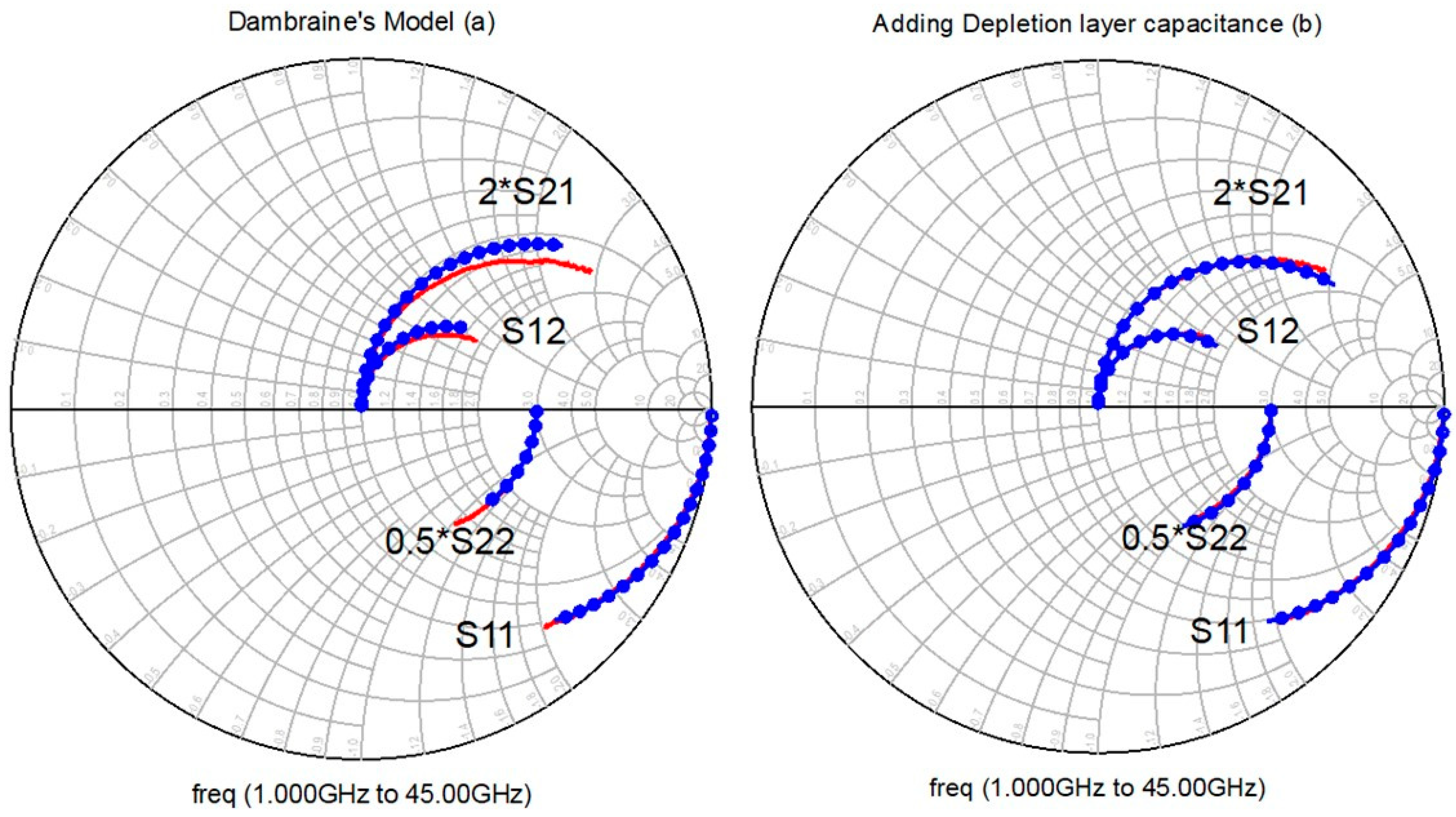
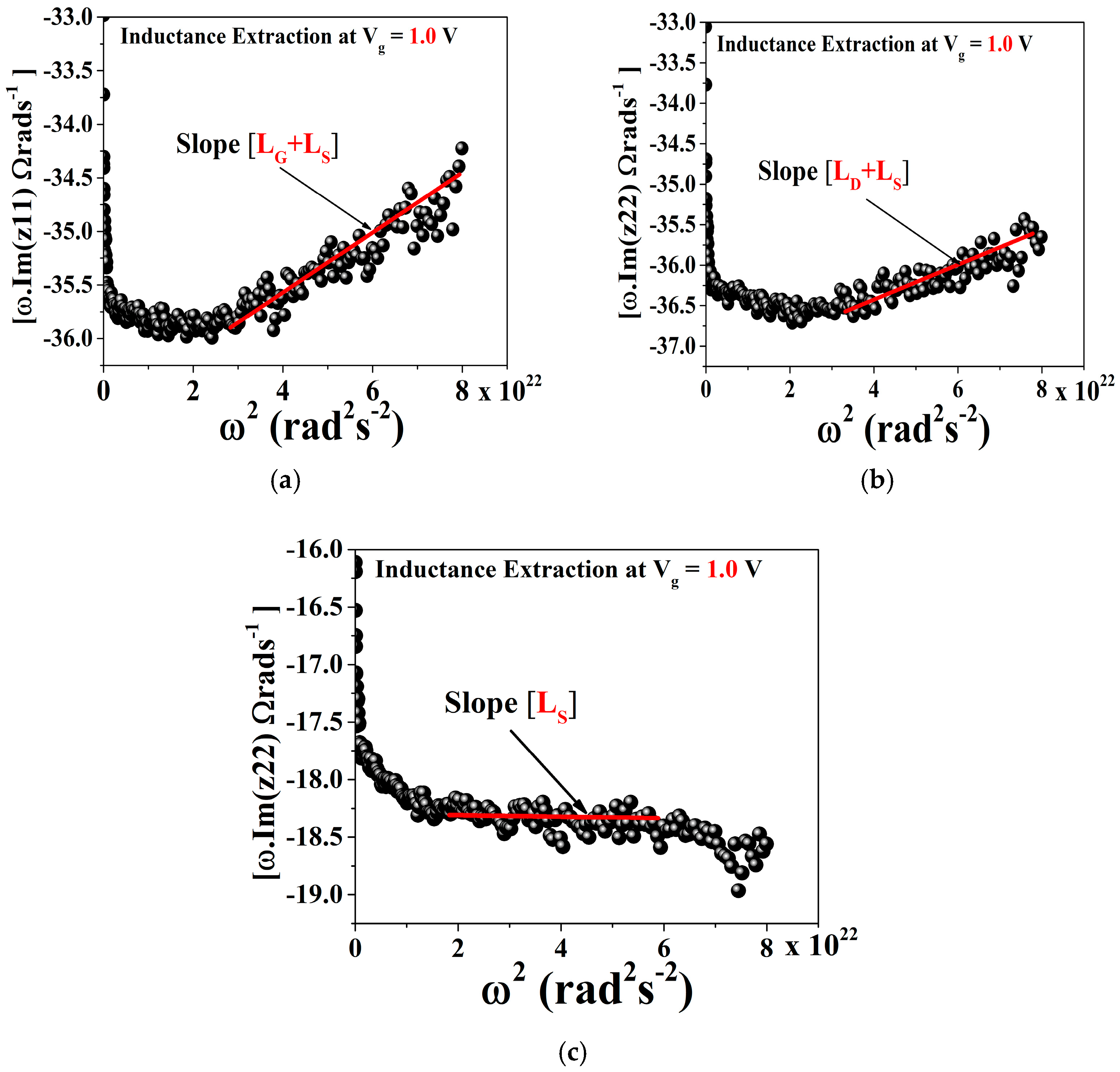

| Frequency | Rs (Ω) | Rd (Ω) | Rg (Ω) | Rch (Ω) |
|---|---|---|---|---|
| 20 GHz | 3.95 | 7.9 | 18.12 | 3.52 |
| 25 GHz | 1.89 | 3.78 | 16.89 | 7.3 |
| 30 GHz | 2.63 | 5.26 | 16.47 | 4.52 |
| 35 GHz | 3.18 | 6.35 | 15.25 | 1.66 |
| 40 GHz | 1.44 | 2.88 | 14.27 | 5.14 |
| Average | 2.62 | 5.23 | 16.20 | 4.42 |
| Frequency | Rs (Ω) | Rd (Ω) | Rg (Ω) | Rch (Ω) |
|---|---|---|---|---|
| 20 GHz | 1.29 | 2.58 | 14.47 | 13.90 |
| 25 GHz | 0.87 | 1.74 | 14.04 | 14.74 |
| 30 GHz | 0.98 | 1.96 | 13.49 | 14.08 |
| 35 GHz | 1.06 | 2.12 | 13.17 | 13.60 |
| 40 GHz | 0.80 | 1.60 | 12.77 | 13.98 |
| Average | 1.00 | 2.00 | 13.58 | 14.06 |
| Frequency | Rs (Ω) | Rd (Ω) | Rg (Ω) | Rch (Ω) |
|---|---|---|---|---|
| 20 GHz | 1.26 | 2.52 | 29.54 | 13.16 |
| 25 GHz | 1.02 | 2.04 | 24.32 | 13.48 |
| 30 GHz | 1.12 | 2.24 | 20.51 | 12.88 |
| 35 GHz | 1.22 | 2.44 | 18.25 | 12.32 |
| 40 GHz | 1.06 | 2.12 | 16.79 | 12.42 |
| Average | 1.14 | 2.27 | 21.88 | 12.85 |
| Parameters | Dambrine’s Model | Proposed Model |
|---|---|---|
| Cpg (fF) | 0.88 | 0.58 |
| Cpd (fF) | 16.7 | 1.19 |
| Extrinsic/Intrinsic | Model Parameters | Extracted Values | Extracted Values |
|---|---|---|---|
| Extrinsic part | Rg | 15 Ω | 9.5 Ω |
| Rd | 26 Ω | 8.0 Ω | |
| Rs | 13 Ω | 4.2 Ω | |
| Lg | 0.1 pH | 4.1 pH | |
| Ls | 20.3 pH | 26.3 pH | |
| Ld | 24.5 pH | 23.4 pH | |
| Intrinsic part | Cgs | 32 fF | 45 fF |
| Cgd | 3.6 fF | 12 fF | |
| Ri | 1.38 Ω | 1.45 Ω | |
| Gm | 20 mS | 26 mS | |
| τ | 0.699 pico sec | 1.23 pico sec | |
| Rds | 1500 Ω | 1800 Ω | |
| Cds | 1.22 fF | 19 fF |
Disclaimer/Publisher’s Note: The statements, opinions and data contained in all publications are solely those of the individual author(s) and contributor(s) and not of MDPI and/or the editor(s). MDPI and/or the editor(s) disclaim responsibility for any injury to people or property resulting from any ideas, methods, instructions or products referred to in the content. |
© 2023 by the authors. Licensee MDPI, Basel, Switzerland. This article is an open access article distributed under the terms and conditions of the Creative Commons Attribution (CC BY) license (https://creativecommons.org/licenses/by/4.0/).
Share and Cite
Chakraborty, S.; Amir, W.; Kwon, H.-M.; Kim, T.-W. New Methodology for Parasitic Resistance Extraction and Capacitance Correction in RF AlGaN/GaN High Electron Mobility Transistors. Electronics 2023, 12, 3044. https://doi.org/10.3390/electronics12143044
Chakraborty S, Amir W, Kwon H-M, Kim T-W. New Methodology for Parasitic Resistance Extraction and Capacitance Correction in RF AlGaN/GaN High Electron Mobility Transistors. Electronics. 2023; 12(14):3044. https://doi.org/10.3390/electronics12143044
Chicago/Turabian StyleChakraborty, Surajit, Walid Amir, Hyuk-Min Kwon, and Tae-Woo Kim. 2023. "New Methodology for Parasitic Resistance Extraction and Capacitance Correction in RF AlGaN/GaN High Electron Mobility Transistors" Electronics 12, no. 14: 3044. https://doi.org/10.3390/electronics12143044





